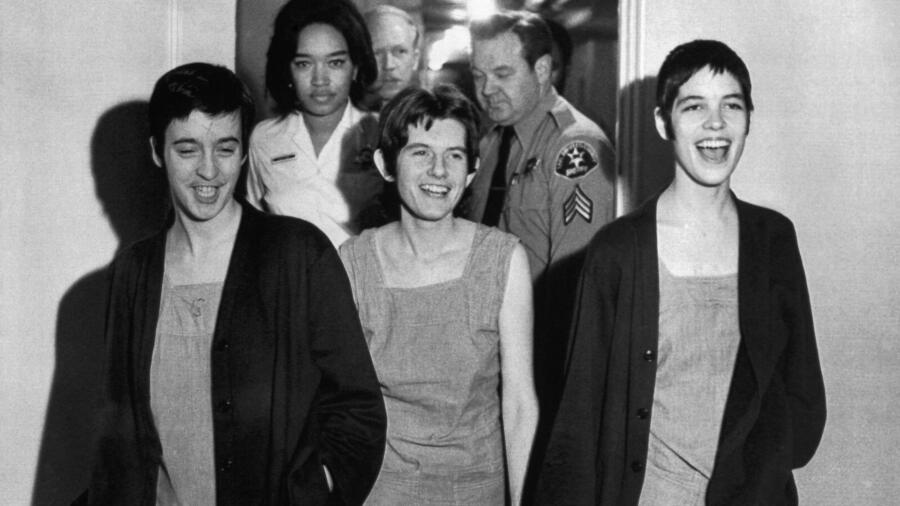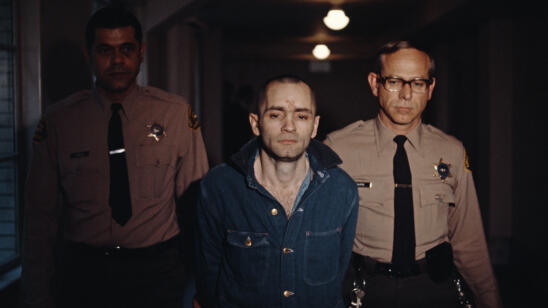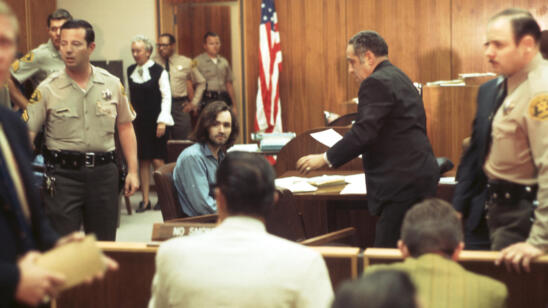The women who latched on to Charles Manson in California’s hippie climate of the late 1960s tended to be young, damaged and sexually willing. But that’s not all. They were also impressionable enough to readily comply when the charismatic commune leader ordered them to commit brutal acts of murder. During a two-night rampage in August 1969, several members of Manson’s ragtag “family”—most of them female—slayed pregnant actress Sharon Tate, 26, and four others at her Benedict Canyon rental home in Los Angeles. The next night, they murdered Leno LaBianca, a successful supermarket executive, and his wife Rosemary, in their Los Feliz home.
Manson, who died in prison in 2017, commanded his followers to commit these acts of savagery to incite a race war he called “Helter Skelter,” named after the Beatles’ song. The lives of his female followers are explored in the Lifetime movie “Manson’s Lost Girls.” Here’s a glimpse into the stories of five Manson girls—and what became of them after they were separated from the man who had so thoroughly dominated their psyches.
Leslie Van Houten
Leslie Van Houten, the youngest of the accused, was a one-time homecoming queen scarred by her parents’ reaction to an unplanned pregnancy. Part of the group that assaulted the LaBiancas, she admitted at trial to stabbing Rosemary more than a dozen times. Her testimony earned her little sympathy: “Sorry is only a five-letter word. It can’t bring back anything,” Van Houten said.
[Watch Manson Speaks: Inside the Mind of a Madman on A&E Crime Central.]
She was sentenced to die in the gas chamber, but the punishment was commuted when the California Supreme Court ruled the death penalty unconstitutional in 1972. She would be re-tried twice during the 1970s. After a 1977 mistrial, she was set free on bond for six months, during which time she worked as a legal secretary and attended the Academy Awards with a friend.
Now 70, Van Houten has accepted responsibility for helping to “create” Manson and has a group of supporters who say she deserves freedom. But the subject is polarizing: Van Houten was OK’d for release by a parole board in 2016, 2017 and 2019, only to see the recommendations quashed by two state governors. She is imprisoned at the California Institution for Women in Corona, California.
Lynette ‘Squeaky’ Fromme
Lynette Fromme was 18 when she met Manson at Spahn Ranch, a filming location that became the family’s main residence in 1968 and ’69. Vincent Bugliosi, who prosecuted the Manson case and wrote the true-crime bestseller Helter Skelter, said Fromme’s primary role there was to appease the ranch’s ailing owner, with the hope he might sign the land over to Manson and his retinue: “Once Manson left the ranch, if he was anywhere else, she was in charge,” Bugliosi wrote.
Fromme didn’t participate in the Tate-LaBianca murders, though she was among the family members routinely present at Manson’s trial. Later locked up for a September 1975 assassination attempt on President Gerald Ford, Fromme had her life sentence extended after a 1987 prison escape; surprisingly, she won parole in 2009, at age 60.
For the last decade, Fromme has lived in upstate New York. In an interview last year, she acknowledged her continued affection for Manson: “I feel very honored to have met him… I know how that sounds to people who think he’s the epitome of evil,” she told ABC. “I don’t think you fall out of love.”
Susan Atkins
Susan Atkins, known within the family as “Sadie Mae Glutz,” was arrested after the Tate-LaBianca murders—but before law enforcement had discovered who was responsible for them. She was convicted, first, for the murder of musician Gary Hinman, a Manson friend, a month before the multiple high-profile homicides that terrorized Los Angeles.
While in a women’s prison, Atkins implicated herself in Tate’s murder, confessing to cellmates that she stabbed the actress and used her blood to write “Pig” on the front door of the Cielo Drive house Tate shared with her husband, film director Roman Polanski. According to Bugliosi, Atkins told one inmate that killing Tate had left her “elated”: “I knew this was just the beginning of Helter Skelter. Now the world would listen.”
People who knew Atkins as a teen recalled a quiet, middle-class girl who sang in a church choir before abandoning high school for the wilder fields of San Francisco’s Haight-Ashbury district. In prison, she denounced Manson and became a born-again Christian. At the time of her 2009 death from brain cancer, she was California’s longest-serving female inmate.
Patricia Krenwinkel
Krenwinkel was a Los Angeles native whose teenage years were scarred by weight issues and an addiction to diet pills. An endocrine problem caused an excess of hair on her body—all factors that made her a mark for Manson.
She was arrested for her part in both the Tate and LaBianca murders. At Tate’s home, she chased and stabbed heiress and social worker Abigail Folger 28 times. It’s believed that Folger’s last words were: “I don’t know why you’re doing this… I’m already dead.” Krenwinkel later said she felt “nothing” while attacking Folger: “I mean, what is there to describe? It was just there, and it was right.” During the LaBianca assault, Krenwinkel carved the word “WAR” on Leno’s stomach.
In a 1994 interview with Diane Sawyer, Krenwinkel said: “I wake up every day knowing that I’m a destroyer of the most precious thing, which is life.” As of last year, she too is incarcerated at the California Institution for Women. She will be eligible for her next parole suitability hearing in 2022.
Linda Kasabian
Kasabian, 20 at the time, is the young woman who ultimately betrayed the family. As driver and lookout, she was witness, but not participant in both nights of terror. Offered immunity from prosecution in exchange for her testimony, she became the trial’s star witness, on the stand for 18 days.
Kasabian was raised by an overextended mother, who shouldered the blame for her daughter’s misguided path. Linda said Manson understood her belief that she was “disposable” to the people in her life. She testified that she was awed by the man, because he could “see right through” her.
Prosecutor Bugliosi said Kasabian’s testimony was the main reason Manson, the three women and Charles “Tex” Watson were convicted. In 2009, a documentarian found her living in a trailer park, under another name. He persuaded her to talk on camera for a documentary, “Manson.” It’s believed that she lives near Tacoma, Washington.
Related Features:
What Drove the Manson Girls to Murder?
What Was Charles Manson’s Childhood Like?
What Was Charles Manson’s Life Like Before He Formed ‘The Family’ Cult?
The 6 Most Bizarre Moments from the Manson Family Murder Trial


